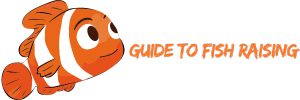Goldfish are popular pets due to their vibrant colors and relatively low maintenance requirements. However, like all pets, they can suffer from health issues. One common problem is the appearance of white specks on their bodies. This article Guide to Fish Raising will explore the causes of white specks on goldfish, how to diagnose the condition, and the best treatment options to ensure your goldfish remains healthy.
Table of contents
ToggleCauses of White Specks on Goldfish
White specks on goldfish can be caused by several conditions, each requiring different approaches for diagnosis and treatment. The most common causes include Ichthyophthirius multifiliis (Ich), Lymphocystis, fungal infections, Epistylis, and calcium deposits. Understanding these causes can help in effectively diagnosing and treating the condition, ensuring the health and well-being of your goldfish.
Ichthyophthirius multifiliis (Ich)
Description:
Ichthyophthirius multifiliis, commonly known as “Ich” or “white spot disease,” is a parasitic infection and the most frequent cause of white specks on goldfish. This parasite has a complex life cycle that includes a free-swimming stage and a parasitic stage, during which it attaches to the fish’s skin, gills, and fins.
Symptoms:
The primary symptom of Ich is the appearance of small, white, salt-like spots on the goldfish’s body, fins, and gills. Infected fish often exhibit rubbing or scratching behavior against objects in the aquarium as they try to relieve the irritation caused by the parasite. Other symptoms include lethargy, reduced appetite, rapid gill movement, and clamped fins. In severe cases, the fish may have difficulty breathing due to the parasites infesting their gills.
Transmission:
Ich is highly contagious and can spread quickly through direct contact between fish or shared water. The free-swimming stage of the parasite allows it to move from one fish to another easily. Contaminated equipment, plants, and even water from an infected tank can introduce the parasite to a healthy aquarium, making prompt quarantine and treatment crucial to prevent widespread infection.
Lymphocystis
Description:
Lymphocystis is a viral infection that affects a variety of fish species, including goldfish. This disease causes the formation of white or pinkish nodules on the skin, fins, and occasionally the gills. The virus infects connective tissue cells, causing them to enlarge and form noticeable growths.
Symptoms:
The most distinctive symptom of Lymphocystis is the presence of wart-like growths on the fish. These nodules can vary in size and are typically fewer and larger compared to the small spots caused by Ich. Unlike Ich, the growths from Lymphocystis are usually confined to specific areas and do not spread rapidly across the fish’s body. Affected fish might not show significant changes in behavior unless the growths interfere with their movement or breathing.
Transmission:
Lymphocystis spreads slowly and is less contagious than Ich. It often affects fish with weakened immune systems, which may be due to poor water quality, stress, or other underlying health issues. The virus can be transmitted through direct contact with infected fish or contaminated water and equipment, but the spread within a healthy, well-maintained aquarium is generally limited.
Fungal Infections
Description:
Fungal infections in goldfish are typically caused by opportunistic fungi that invade damaged or weakened tissue. These infections often occur secondary to injuries, poor water quality, or other illnesses. The fungi form white, cotton-like growths on the affected areas, giving the appearance of white patches or tufts.
Symptoms:
Fish suffering from fungal infections exhibit white patches or cotton-like tufts on their skin, fins, or gills. These growths can spread if left untreated, and the affected fish may become lethargic, lose appetite, or display signs of distress. Unlike Ich, fungal infections often appear in localized areas where the tissue has been damaged, such as wounds or lesions caused by rough handling or aggressive tank mates.
Transmission:
Fungal infections are generally not highly contagious but can spread through water or contact with infected surfaces. Maintaining clean water conditions and promptly treating injuries or primary infections can help prevent fungal outbreaks. Contaminated equipment and decor can also harbor fungal spores, so thorough cleaning and disinfection are important.
Epistylis
Description:
Epistylis is a protozoan parasite that forms white to grayish tufts on the skin, fins, and gills of fish. Unlike other protozoan infections, Epistylis attaches itself to the fish’s body and creates visible tufts that resemble cotton wool.
Symptoms:
The presence of fine, white tufts on the goldfish is the primary symptom of an Epistylis infection. These tufts can cause the fish significant discomfort, leading to signs of distress and lethargy. Infected fish may also exhibit reduced appetite and erratic swimming patterns as they try to cope with the irritation caused by the parasite.
Transmission:
Epistylis infections are usually associated with poor water conditions or stress, which can weaken the fish’s immune system and make them more susceptible to parasites. The protozoan can spread through direct contact with infected fish or contaminated water. Improving water quality and reducing stress are critical steps in preventing and managing Epistylis infections.
Calcium Deposits
Description:
Calcium deposits are harmless accumulations of calcium that can appear as white spots on a goldfish’s scales. These deposits are typically a result of dietary or water chemistry factors and do not indicate a disease or parasitic infection.
Symptoms:
The white specks caused by calcium deposits are usually stable and do not cause changes in the fish’s behavior or spread to other areas of the body. Unlike infectious conditions, these spots are not associated with any physical distress or secondary symptoms.
Transmission:
Calcium deposits are not contagious and are usually linked to the fish’s diet or the mineral content of the water. Adjusting the fish’s diet and ensuring balanced water chemistry can help prevent the formation of these deposits. Regular monitoring of water parameters and providing a varied diet can keep these spots under control.
Diagnosing White Specks on Goldfish

Accurate diagnosis is crucial for effective treatment. Here’s how to differentiate between the causes of white specks:
Observe Behavior and Symptoms:
- Ich: Look for rubbing or scratching behavior, lethargy, and rapid gill movement.
- Lymphocystis: Note the size and location of the nodules. Lymphocystis nodules are typically larger and fewer.
- Fungal Infections: Identify any cotton-like growths, especially on damaged areas.
- Epistylis: Look for fine, tuft-like growths and signs of stress.
- Calcium Deposits: Check if the spots are stable and do not affect the fish’s behavior.
Water Testing:
- Parameters: Test for ammonia, nitrite, nitrate, pH, and hardness. Poor water quality can exacerbate infections.
- Temperature: Ensure the water temperature is appropriate for goldfish (generally 65-72°F or 18-22°C).
Microscopic Examination:
- Procedure: If possible, take a sample of the white specks and examine under a microscope. This can help identify parasites, fungal spores, or other pathogens.
Professional Consultation:
- Vet Visit: For a definitive diagnosis, consult a veterinarian specializing in fish. They can perform detailed examinations and recommend precise treatments.
Treating White Specks on Goldfish
Treatment depends on the underlying cause of the white specks. Here are the recommended approaches for each condition:
Ichthyophthirius multifiliis (Ich):
- Increase Temperature: Gradually raise the water temperature to 78-80°F (25-27°C) to speed up the parasite’s life cycle, making it more susceptible to treatment.
- Medication: Use over-the-counter Ich treatments containing malachite green, formalin, or copper. Follow the dosage instructions carefully.
- Salt Bath: A salt bath (1-2 teaspoons of aquarium salt per gallon) can help alleviate symptoms and kill parasites.
- Quarantine: Treat affected fish in a separate quarantine tank to prevent spreading.
Lymphocystis:
- No Cure: There is no direct cure for Lymphocystis. The best approach is to improve water quality and provide a stress-free environment.
- Boost Immune System: Feed a high-quality diet and consider adding vitamins or supplements to strengthen the fish’s immune system.
- Quarantine: Isolate infected fish to prevent potential secondary infections.
Fungal Infections:
- Antifungal Medication: Use antifungal treatments available in pet stores. Common ingredients include methylene blue or malachite green.
- Salt Bath: A salt bath can also help treat fungal infections.
- Clean Environment: Ensure the aquarium is clean and free of organic debris that could harbor fungal spores.
Epistylis:
- Improve Water Quality: Address underlying water quality issues by performing regular water changes and cleaning the tank.
- Medication: Use anti-parasitic treatments recommended for Epistylis. Formalin and potassium permanganate can be effective.
- Salt Bath: Salt baths can help reduce protozoan populations and relieve fish stress.
Calcium Deposits:
- Monitor Diet: Ensure the fish is receiving a balanced diet. Avoid excessive feeding of calcium-rich foods.
- Water Chemistry: Maintain stable water parameters to prevent further calcium buildup.
- Observation: Since calcium deposits are harmless, monitor the spots and ensure they do not indicate a more serious issue.
Preventing White Specks on Goldfish
Prevention is always better than cure. Here are some tips to prevent white specks on your goldfish:
Maintain Water Quality:
- Regular Testing: Test water parameters regularly and adjust as needed.
- Frequent Water Changes: Perform partial water changes weekly to keep the water clean and free of toxins.
- Filter Maintenance: Clean and maintain filters to ensure effective removal of waste and debris.
Quarantine New Fish:
- Isolation Period: Quarantine new fish for at least two weeks before introducing them to the main tank. This helps prevent the introduction of parasites or diseases.
- Observation: Monitor new fish for any signs of illness during the quarantine period.
Balanced Diet:
- High-Quality Food: Provide a varied diet of high-quality flakes, pellets, and fresh vegetables to ensure your goldfish receive all necessary nutrients.
- Avoid Overfeeding: Feed small amounts multiple times a day rather than one large feeding to prevent excess waste and water pollution.
Stress Reduction:
- Stable Environment: Keep the tank in a quiet area with consistent lighting and temperature.
- Avoid Overcrowding: Ensure the tank is appropriately sized for the number of fish to reduce stress and aggression.
Regular Observation:
- Daily Check: Spend a few minutes each day observing your goldfish. Early detection of health issues can lead to quicker and more effective treatments.
Conclusion
White specks on goldfish can be caused by various conditions, including Ich, Lymphocystis, fungal infections, Epistylis, and calcium deposits. Accurate diagnosis and appropriate treatment are essential to ensure the health and well-being of your goldfish. By maintaining optimal water quality, providing a balanced diet, and reducing stress, you can prevent these issues and keep your goldfish thriving. Regular observation and prompt action are key to addressing any health concerns early and effectively.





